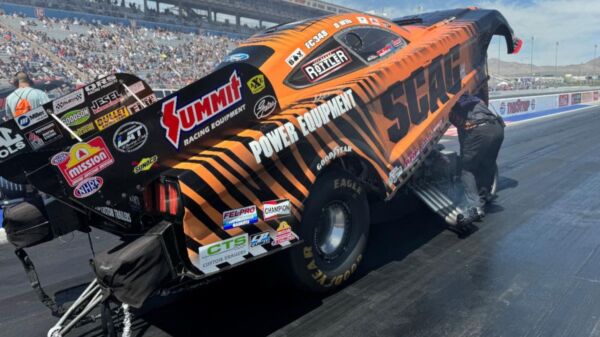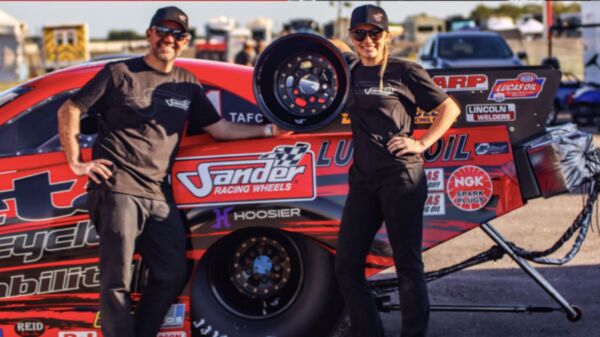There’s only one “Dream Team” when it comes to radial tire racing, and that’s none other than the epic partnership between Southern Speed Promotions’ Tyler Crossnoe and VP Racing Fuels’ Jason Rueckert. The two men took the radial tire world by storm when they started working together half a decade ago and dominated the track prep scene with their unparalleled skill; now they are some of the most highly sought-after traction gurus and event promoters out there. Crossnoe and Rueckert’s latest collaboration, though, isn’t all about the racing surface – it’s about the racing itself.
 Their newly-created Limited Drag Radial (LDR) class has spawned a dedicated mini-series to which racers – and major sponsors and manufacturers – are flocking in droves. An eighth-mile, heads-up category running on a .400 Pro Tree with a Pro ladder, Limited Drag Radial is a single power adder class and began its inaugural season in 2016. LDR door cars must retain their original appearances, profiles, and dimensions. Back-half style cars are permitted, but full tube chassis cars, as well as wheelie bars, are strictly prohibited. There is no cubic inch limit on the engines themselves, but guidelines and weights are defined given the different power adders and setups. Lastly, racers may run on any 275/60/15 drag radial or 315/60/15 drag radial tire.
Their newly-created Limited Drag Radial (LDR) class has spawned a dedicated mini-series to which racers – and major sponsors and manufacturers – are flocking in droves. An eighth-mile, heads-up category running on a .400 Pro Tree with a Pro ladder, Limited Drag Radial is a single power adder class and began its inaugural season in 2016. LDR door cars must retain their original appearances, profiles, and dimensions. Back-half style cars are permitted, but full tube chassis cars, as well as wheelie bars, are strictly prohibited. There is no cubic inch limit on the engines themselves, but guidelines and weights are defined given the different power adders and setups. Lastly, racers may run on any 275/60/15 drag radial or 315/60/15 drag radial tire.
This is the first year that Limited Drag Radial has been around. How did it get started?
Jason Rueckert: I’ve been in radial racing since about 2005, and I’ve followed the progression of it over the years. I liked where it used to be, but now, how the heck can the average racer keep up with what’s going on? You’ve got guys like Keith Haney building cars specifically to run just two races a year. There was no class for the original radial guys except for maybe Outlaw Drag Radial at Donald Long’s events twice a year – everything else runs Radial vs. the World rules and that’s a lot more than what most people can afford. We needed a middle ground. Radial racing was never meant to be the number one class; it was always meant to be the filler whether it was with Outlaw 10.5, Pro Mod, or whatever, but now radial racing is the top dog.
Tyler Crossnoe: There was a big bridge between Radial vs. the World and X275, and Outlaw 275 rules were different across the country. So, we got a couple of people involved and tried to get a lot of combinations that were legal with Outlaw Drag Radial and Outlaw 275 mixed in. We wanted to make a class where people could go 4.20s and be competitive, and that’s how I got started. There are probably at least thirty cars just sitting in garages right now that had no place to go but could win a Limited Drag Radial race. It took us about three months in 2015 to get the first set of rules accomplished and approved by a few ex-racers and others on the initial committee.
How is Limited Drag Radial different than Outlaw Drag Radial or Radial vs. the World?
JR: It’s a middle class. With Radial vs. the World, the payout is huge and people run purpose-built cars. We don’t

Jason Rueckert
pay more than $5,000-to-win but we pay further back into the ladder; we try to keep it where it’s nice to win the cash but it isn’t going to change someone’s plans for the season to cherry-pick for money. We want to make it a fun class that’s obtainable for the average guy. We want personalities, not celebrities.
TC: The main difference is that Limited Drag Radial is a little more forgiving. Outlaw Drag Radial is really strict for certain combinations or chassis setups. In Radial vs. the World, you’ve got to have a six- or seven-figure operation to compete, and not many people can swing that. A lot of guys are in simply in between, and Limited Drag Radial was created for them.
What sort of elapsed times did you guys have in mind when putting LDR together?
TC: Our goal was to have guys running in the 4.20s, but on a good track, we expected someone could run in the 4.10s. We accomplished that right off the bat with the rules, and Don Burton went 4.146 at Maryland International Raceway in prime conditions. We’ve got guys like “Mustang Mike”, Eric Gustafson, Barry Mitchell, Isaac Preston and others all out there killin’ it. We know it’ll get faster, that’s the progression of the class, but right now it’s exactly where we want it to be.
JR: The goal was 4.20-4.30s – something that we knew a lot of cars were capable of. Plus, we felt like it would make for some really exciting, side-by-side racing that both the drivers and the fans love.
How are things going so far with the class in this first season?
TC: I’m really happy with where we’re at after these first six months. We’ve had solid growth and good support from our racers. We’ve talked to certain chassis builders and one guy has four cars in his shop right now being built for Limited Drag Radial. A lot of guys are starting to come back after being out of it for a few years.
JR: Lots of guys are happy with the rules and the car counts at our events are really strong. We need a class that will live for years to come. Yes, it’ll be more restrictive from the get go, but if we let it escalate too quickly, it won’t live. We’re protecting the longevity of the class and preserving its future by making the rules so that even if someone has big money, it doesn’t mean they can go faster than anyone else.
What does the LDR schedule for 2016 look like?

Tyler Crossnoe
TC: We’ve run at the U.S. Street Nationals at Bradenton Motorsports Park in Florida in January – that was our first
event. Then we ran at the Outlaw Street Car Reunion in March at Tennessee’s Memphis International Dragway, Radial Fest at Huntsville Dragway in Alabama in April, and the Ohio Valley Prize Fight in May in Kentucky. PSCA just added Limited Drag Radial to the Street Car Super Nationals: Anarchy at the Arch event in August in St. Louis, the Radial Tire Racing Association (RTRA) may run an LDR class at their Denton, Texas race, and we’ll be back at Huntsville for Radial Fest in October, possibly with a few other events added in.
Is there an LDR points championship on the line this year?
TC: We’ve talked about it, and we’ll most likely have a points championship in the 2017 season instead. We thought about doing it this year but wanted to get going and see how things went first.
JR: We’d like to get a five or six race series. We wouldn’t offer huge cash payouts, but manufacturers would give prizes and parts that would make it really worthwhile for racers.
What do you predict for the future of the class?
TC: A major organization with a points series has approached us about adding Limited Drag Radial to their program, but it’s not official yet. We think it would be a good fit with a lot of cars. Whether or not that happens, though, we’ll still run LDR at several events and big radial races throughout the country.
JR: We’re working really hard to maintain parity between all the power adders and combinations. I’ve raced for twenty years, and what I really want more than anything is to see is this class grow and survive, and, in two years, to have it be the top working man’s radial class.
This story originally appeared in Drag Illustrated Issue No. 112, the Interview Issue, in August of 2016.
Photographs by Chris Sears and James Sisk
This story was originally published on December 2, 2016. 























